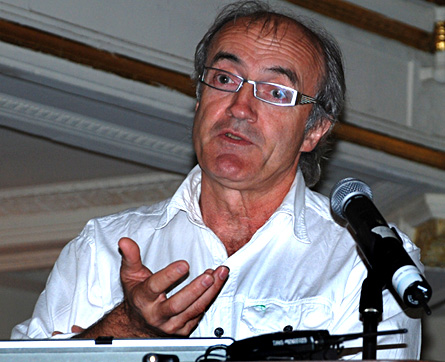How Would Carnegie Judge Our Digital Libraries?
In Pittsburgh, the city of Andrew Carnegie, books — and libraries — hold a revered status. So when Bill Buxton, the Toronto-based principal scientist for Microsoft Research, was asked to speak to the Joint Conference on Digital Libraries in Carnegie-land this morning, he decided to focus on how Carnegie had ushered in a transformation in library design. And he ended his keynote address by observing that the ongoing transition from paper to virtual publications has been a rocky one. His primary criticism: Its design has proven poor — if not haphazard.
Over an hour, he escorted us through a nostalgic conceptual walk from a few of the 2,509 brick-and-mortar libraries that Carnegie endowed to the virtual libraries of today. And I can’t speak for all of the JCDL attendees, but it certainly made me hunger for the good-old days. When books were — well — books. Paper-based objects that were easy to read, to skim, and to stick in a pocket or at least a handbag. And when libraries were an almost hallowed architectural presence in which to seek access to wisdom.
Indeed, as a designer, Buxton argued that the sense of place plays an important role in how we process information.
“Thoughts exchanged by one and another are not the same in one room as in another,” he said, quoting architect Louis I. Kahn. So the environment in which information or ideas are made available can matter. Conversations in a conference hall, for instance, will differ from those in a living room or pub, even if the words exchanged were identical. How we feel when we hear those words — exhilarated by architectural majesty, relaxed and slouching in an easy chair, or straining to hear what’s being said against a background din and pall of smoke — can affect both our receptivity and ability to connect ideas.
Similarly, Buxton argues, books read online are not the same as those read on paper. The same is true for e-books, those boxes that electronically display text (anything from Shakespeare’s plays to engineering primers or bodice-ripping romances). For these would-be books, the size of the typed words, the contrast between text and “page,” and the material used as a cover (leather, versus hard or soft plastic) can all alter the reading experience.
Unfortunately, he contends, design has not been a primary consideration in engineering digital media. Most major bookstores host long shelves of how-to tomes for software. Each title, he says, “Only exists because of the terrible design of the products [software].”
He joked about how a key selling feature for e-books is their “usability.” How ironic. Nobody will win an award for building a bridge that doesn’t fall down. That they remain standing despite the abuse we put them through — “that’s taken for granted,” says Buxton. That digital media will work almost as well as the technology they replace should also be taken for granted, he argues. In fact, as we know all too well, it can’t.
Until it can, Buxton charges that the digital world won’t be able to achieve anything like the revolution in making knowledge accessible that Carnegie did. Carnegie made librarians a user-friendly interface with the mountains of books at any institution. Your computer’s browsers attempt to do that, and often fail.
Carnegie’s libraries were usually the most grandiose architectural structure in town, and the inevitable steps leading to their front doors reinforced that readers were about to be “uplifted.” A lamppost out front symbolized the enlightenment that was available inside. Do you feel about to be uplifted when you boot up your laptop?
Carnegie also realized that the books weren’t themselves special, but a means to education, knowledge, and culture. Yet the data purveyors of today’s digital worlds don’t seem to understand that just warehousing data doesn’t foster learning and knowledge. People must be able not only to find what they seek, but to easily browse and find things they didn’t realize were available. Web browsers, however, don’t actually browse very well. They’re more searching systems — and they often don’t search all that well either, he maintains.
As we are increasingly forced to visit digital libraries, we tend to become annoyed by what we have lost. True, when the text you seek is available, it’s available almost anywhere and almost instantaneously. But finding things can be difficult, reading them can strain the eyes, and trying to highlight passages that matter may be impossible (unless we first print them out). Skimming can take a long time and be annoyingly cumbersome.
Buxton argues that designers — not function-driven engineers — should look to emulate with some digital “prosthetic” the presence that is “lost” when we must navigate through electronic libraries. Moreover, he says browsers will fail us all until they exhibit the diversity of formats that “ink browsers — paper” — offers today. From post-it notes and billboards to labels on packaging and the morning newspaper, printed information comes in a wealth of sizes, colors, even textures that have evolved over centuries to meet society’s many needs.
Right now, digital media offer a poor substitute. We can and must do better, he said.
Oh, how right he is.








